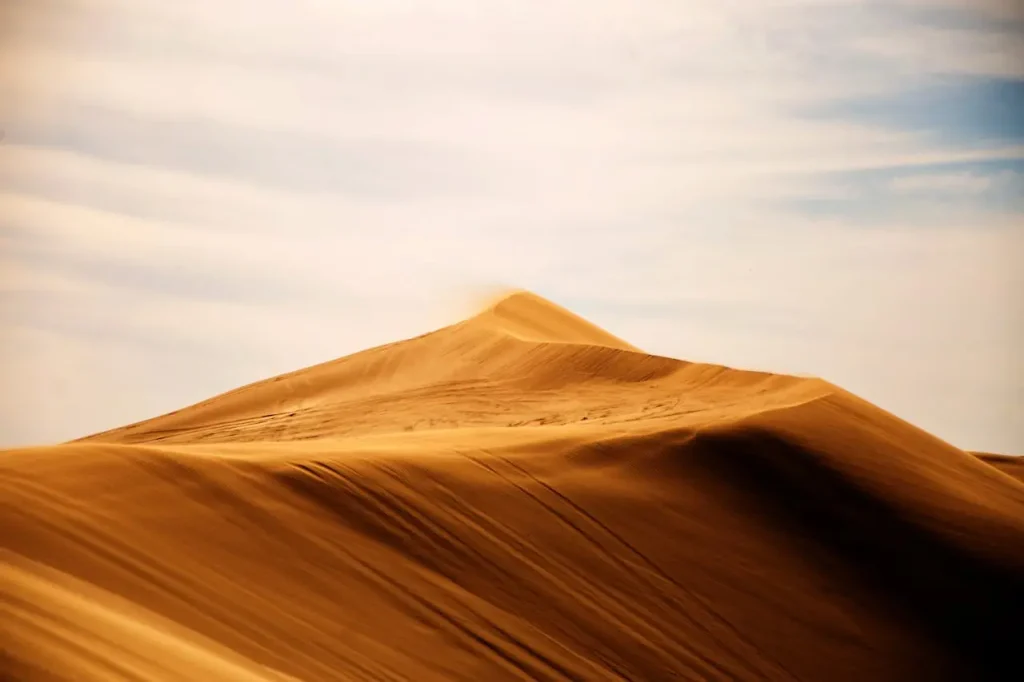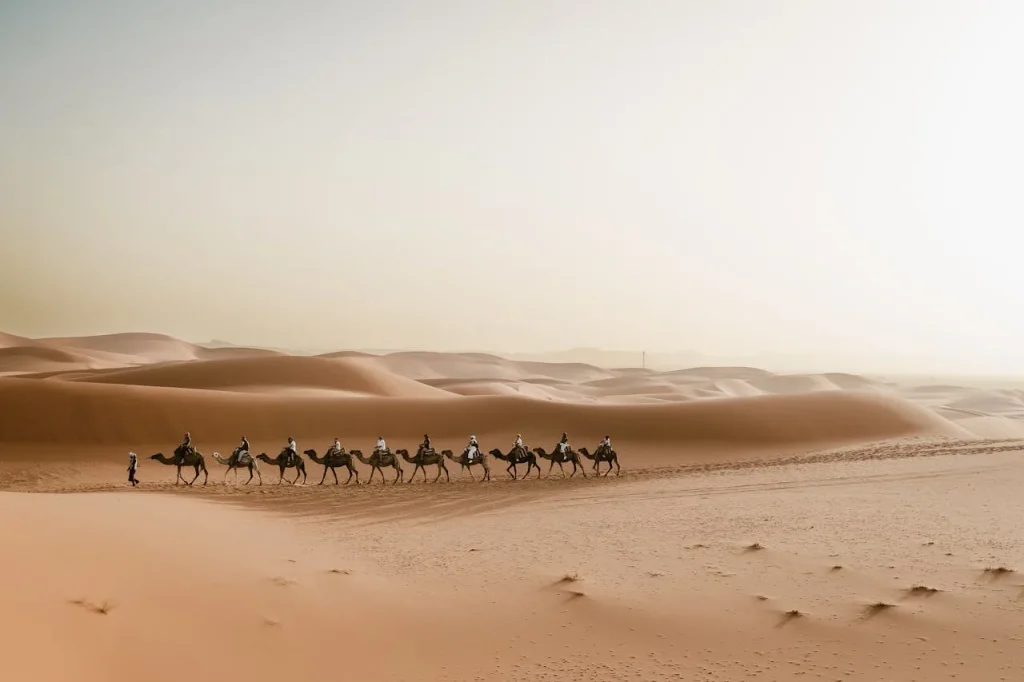Table of Contents
Introduction
Why Deserts Fascinate Us: A World of Extremes
Deserts are among the most extraordinary landscapes on earth, representing extremes that easily challenge the human mind. They are not only arenas for testing human survival but also areas where nature thrives in the most impossible conditions. Stark, unsightly places-mostly inhospitable-may come with a strange kind of allure: solitude, endless horizons, and mystery are all undeniable elements.
Understanding the World’s Deserts: Beyond Sand and Heat
While people think of dunes and sandstorms when hearing the word desert, deserts are actually defined by their aridity, having less than 10 inches of rainfall a year. So, deserts can be ice-covered, frozen desolate expanses like Antarctica or vast, sandy realms like the Sahara. Every desert has its own story to tell about geology, climate, and life and is therefore critical to understanding the diversity of our planet.
Where’s the World’s Largest Desert?
Defining a Desert: It’s More Than Just Sand
A desert is defined not by temperature but by a lack of precipitation. This makes some deserts snowy rather than sandy, which dispels the traditional view most people have. From the icy tundra of the poles to the arid zones near the equator, deserts are as diverse as the ecosystems they host.
The Surprise Contender: Antarctica as the Largest Desert
This was the most astonishing, that Antarctica is the largest desert in the world. Measuring around 14 million square kilometers, this cold wilderness receives fewer annual falls than the Sahara. In contrast, its severe frozen beauty is camouflaged with an adapted ecosystem for extreme cold and dryness.
Why Antarctica is a Desert: Exploring the Science of Arid Regions
A desert is dry by definition, not cold. Cold air in Antarctica contains little moisture, which means that this region is one of the driest, where there is no significant rainfall and an apparent sea of ice stretches as far as the eye can see, reminding one of the domain over climate in landscapes.
Largest Desert in the World in Which Country
Understanding the Role of Countries in Desert Geography
Most deserts are located in multiple countries and cross political borders. The Sahara is an example that crosses 11 North African countries, and Antarctica is a whole territory managed by several nations and no sovereign country.
Shared Territories: Deserts Across Multiple Nations
Deserts often bridge the borders: from southern Africa’s Kalahari to the Middle East, spanning across the vast expanse of the Arabian Desert. Such geographies encourage varied cultural interactions as well as difficult environmental conditions across bordering states.

Largest Desert in the World Antarctica or Sahara
Comparing Antarctica and the Sahara: Cold vs. Hot Deserts
Antarctica’s climate plains sharply contrast with the Sahara Desert, scorching hot sands. However, both are technically deserts. One is a frozen expanse, the other a hot, dry wasteland, and they are at the extremes of Earth’s climatic zones.
Size Matters: How the Two Giants Measure Up
Almost double the size of the Sahara, Antarctica’s cold, unbearably freezing ground differs greatly from Sahara’s busy trade routes and nomadic lifestyles.
Largest Hot Desert in the World
The Sahara: A Landscape of Extremes
The Sahara covers over 9 million square kilometers of land, with huge parts of North Africa. The sandy dunes and very hot temperatures give birth to an iconic landscape otherworldly.
What Makes the Sahara the Largest Hot Desert
The size and climate of this place, therefore, make it unique. Its amazing variety of landscapes, such as ergs, or sand seas, rocky plateaus, and old riverbeds, are also a part of this Sahara.
2nd Largest Desert in the World
Arctic Desert: The Runner-Up You Didn’t Expect
The Arctic Desert ranks at second place, cold and frigid compared to the Sahara Desert. Extensive ice sheets and tundra land, exemplifying diversity, rank the Arctic Desert at second place.
How Cold Deserts Differ from Hot Deserts
The climatic conditions are different between cold and hot deserts, despite them both being arid. Cold deserts are icy with a minimum of flora, while hot deserts are dry with only scattered flora.
Biggest Sand Desert in the World
Rub’ al Khali: The Empty Quarter of the Arabian Peninsula
The Rub’ al Khali is the largest sand desert in the world, stretching over 650,000 square kilometers. Endless dunes create a marvelous yet tough environment.
Exploring the Vastness of the World’s Largest Sand Desert
Dunes can reach 250 meters. The desert, however, has become a symbol of natural wonder, but for me, this place is so significant because ancient trade routes cut through it.
Top 10 Biggest Desert in the World
A Look at the World’s Biggest Deserts by Area
From Antarctica to the Gobi, the world’s largest deserts reveal its geographical diversity. Each one has a unique story to tell based on climate and history.
Unique Features of Each Desert: From the Gobi to the Patagonian
Each highlights a different varied terrain of this planet. But perhaps the main feature that describes a desert would be its wind-borne expanses. Comparatively speaking, what a contrast from each: Gobi- a rocky landscape of vast desert; Patagonian Desert windswept and arid yet gentle.
Where Is the World’s Largest Desert Lake Situated?
Lake Turkana: The Jewel of the Desert
Lake Turkana is a desert lake, and it’s the largest desert lake in the world. The emerald water of the lake contrasts the dry surroundings to produce a very visual spectacle.
Why This Lake is a Natural Wonder
An Ecosystem of its own, there are crocodiles and flamingos, providing a vital spot for ecological as well as cultural activities.
Can You Travel to the Sahara Desert?
Planning Your Sahara Adventure: Travel Tips and Safety
Traveling to the Sahara Desert calls for careful planning to ensure safety and enjoyment. First, consider the right season for traveling. The best seasons for traveling to the Sahara Desert are autumn and spring, as they are relatively less hot than in summer or less cold than at night in winter.
Packing is crucial for desert travel. Essentials include lightweight, breathable clothing, a wide-brimmed hat, sunscreen, and sunglasses to protect against the sun. Comfortable walking shoes are a must, as is a scarf or shawl to shield your face during occasional sandstorms. Don’t forget plenty of water, high-energy snacks, and a first-aid kit.
Travel with a competent guide or tourist agency that understands the desert itself and its particular conditions. One can have an upscale camp or go into a Berber tent. When traveling to extreme locations, bringing satellite phones or GPS devices could be a precaution since cell telephone services may sometimes be unreliable or even unavailable at all.

What to Expect: Climate, Terrain, and Cultural Insights
One of the defining features of the Sahara is its climate. Days are hot, with temperatures often reaching above 40°C (104°F) during summer, and nights can be quite cool, especially in winter. Be prepared for this extreme temperature difference by layering your clothes.
The territory varies in landscapes such as sand dunes that are wide expanses, rock plateaus, gravel plains, and ancient dried-up riverbeds. From the rolling dunes of Erg Chebbi to the Hoggar Mountains rugged cliffs, every single place presents its view on desert splendor.
Cultural experiences are part and parcel of any Sahara expedition. The harsh conditions have been able to sustain nomadic Berber and Tuareg communities for thousands of years. Warm hospitality, rich traditions, and deep attachment to the desert give a human face to the journey. Taste their food, listen to their music, and learn about their lifestyle for a totally immersive experience.
Traveling to the Sahara is not just a physical journey; it is an opportunity to explore one of the most awe-inspiring landscapes on Earth and connect with a way of life shaped by resilience and harmony with nature.
Can You Tour the Sahara Desert?
A Guide to Experiencing the Sahara’s Vast Beauty
From camel treks to gazing at stars under unpolluted skies, the Sahara offers un-forgivable adventures for intrepid travelers.
Popular Tourist Destinations in the Sahara
Visit some of the dunes, like Erg Chebbi in Morocco, or some of the ancient ruins of Ghadames in Libya.
What Animal Lives in the Sahara Desert?
The Sahara’s Resilient Wildlife: An Overview
Despite the harsh conditions, the Sahara is surprisingly able to support a great range of life, from fennec foxes to desert-adapted reptiles and insects.
Adaptations That Help Animals Survive the Harsh Climate
Saharan animals are highly adapted with features like water conservation, nocturnal lifestyles, and heat-reflective features.
Conclusion
Why Deserts Matter: Their Role in the Planet’s Ecosystem
Deserts play very important roles that regulate Earth’s temperature, hold unique biodiversity, and preserve geological history dating way back.
The Enduring Allure of the World’s Most Extreme Landscapes
Deserts are awe-inspiring and curious. They remind one of the resilience of nature and the boundless diversity of life on Earth.
Call to Action
Where’s the World’s Largest Desert? Dive deeper into the amazing world of deserts now. From trekking the Sahara Desert to walking on the ice expanse of Antarctica, there’s something for everyone. So be ready and learn about the unique desert landscapes that exist around the globe.
Share your opinions in the comment section, and plan your desert journey next! Follow us to learn more enthralling stuff about the natural world. Let’s uncover the secret of these extreme landscapes together.
